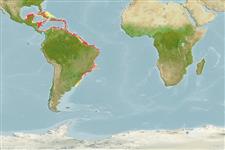Bivalvia |
Ostreida |
Ostreidae
Environment: milieu / climate zone / depth range / distribution range
Ecology
Benthic; brackish; depth range 0 - 50 m (Ref. 104365). Tropical, preferred 27°C (Ref. 107945); 25°N - 35°S, 96°W - 34°W
Atlantic Ocean: from southern Gulf of Mexico to Uruguay. Introduced in UK.
Length at first maturity / Size / Weight / Age
Maturity: Lm ? range ? - ? cm Max length : 12.0 cm NG male/unsexed; (Ref. 271)
Diagnostic features: Shell lightweight, deep-cupped inequivalve, left valve (attached) larger than right. Shell shape and outline variable. Inner margin smooth. Presidium transversally striated. Colour: externally dirty light grey, internally whitish or light grey splotched with bluish purple (Ref. 271).
It has a total length of 12 cm. Fisheries: It is heavily exploited due to over exploitation or contaminated by organic pollutants. It is consumed raw, fried, grilled or boiled. Canned industrially (Ref. 271). Attached to roots of Rhizophora mangle, rocks or other oyster shells. It is mostly intertidal or shallow-subtidal species (Ref. 271).
Life cycle and mating behavior
Maturity | Reproduction | Spawning | Eggs | Fecundity | Larvae
Members of the class Bivalvia are mostly gonochoric, some are protandric hermaphrodites. Life cycle: Embryos develop into free-swimming trocophore larvae, succeeded by the bivalve veliger, resembling a miniature clam.
Carpenter, K.E. (ed.) 2002 The living marine resources of the Western Central Atlantic. Volume 1: Introduction, molluscs, crustaceans, hagfishes, sharks, batoid fishes, and chimaeras. FAO Species Identification Guide for Fishery Purposes and American Society of Ichthyologists and Herpetologists Special Publication No. 5, Rome. 600p. (Ref. 271)
IUCN Red List Status
(Ref. 130435: Version 2025-1)
CITES status (Ref. 108899)
Not Evaluated
Not Evaluated
Threat to humans
Human uses
Fisheries: commercial
FAO - Aquaculture: production; Fisheries: landings | FishSource | Sea Around Us
Tools
More information
Population dynamicsGrowthMax. ages / sizesLength-weight rel.Length-length rel.Length-frequenciesMass conversionAbundance Life cycleReproductionMaturityFecunditySpawningEggsEgg developmentLarvae PhysiologyOxygen consumption
Human RelatedStamps, coins, misc.
Internet sources
Estimates based on models
Preferred temperature
(Ref.
115969): 26.2 - 28, mean 27.3 (based on 170 cells).
Resilience
High, minimum population doubling time less than 15 months (K=2.79).
Prior r = 0.81, 95% CL = 0.54 - 1.22, Based on 1 data-limited stock assessment.
Fishing Vulnerability
Low vulnerability (10 of 100).
Climate Vulnerability
High vulnerability (57 of 100).
Nutrients : Calcium = 149 [71, 228] mg/100g; Iron = 8.53 [1.95, 15.11] mg/100g; Protein = 9.88 [8.64, 11.12] %; Omega3 = 0.313 [0.202, 0.423] g/100g; Selenium = 61 [50, 72] μg/100g; VitaminA = 0 μg/100g; Zinc = 2.04 [0.56, 3.51] mg/100g (wet weight); based on
nutrient studies.
